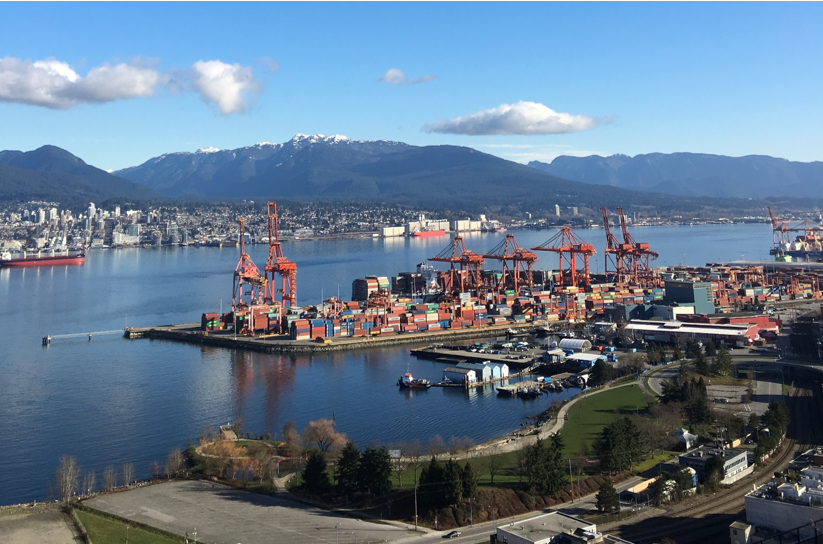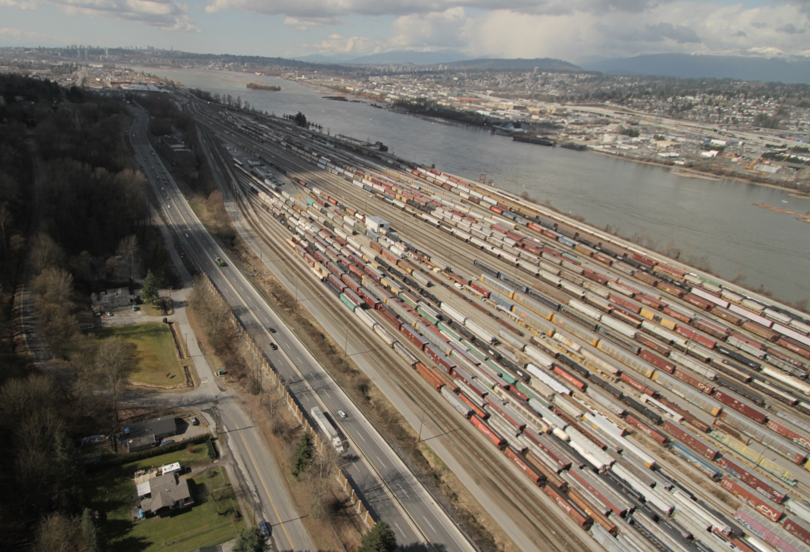 TAC spotlight article
TAC spotlight articleContainer terminals along B.C.’s west coast are essential to the local and national economy, providing a critical link between consumers and businesses with global markets. To put this in perspective, the Port of Vancouver handles $1 of every $3 of Canada’s goods traded outside of North America.[1] Whether it is a new pair of sneakers, a flat screen TV, or coffee beans – the chances are that you have purchased something which has arrived in a container recently.
Fall is a particularly busy time of year for the container shipping industry due to the upcoming holiday season. This time of year, more than 36,000 TEUs typically arrive in the Port of Vancouver on an average week[2] (TEU means twenty-foot equivalent units, which is a way of measuring container volumes) - so what happens after a container is unloaded at one of our terminals and how do goods from overseas reach our store shelves? This short case study examines a typical container shipment from Ningbo, China to Vancouver, Canada, including how our supply chain networks are utilized on a regular basis and how owners are meeting growing demands with substantial upgrades.
What may come as a surprise, is that certain containers moving through Vancouver’s Lower Mainland may travel along our transportation infrastructure twice before the goods reach our stores. In this case, an import container from overseas may depart Vancouver on rail to an out of province distribution center, and then return to Vancouver for delivery via truck. In other words, our goods are traveling more miles than they need to with respect to the first mile / last mile in the supply chain. This requires infrastructure owners to consider high volumes of truck traffic along designated routes within our road and highway networks, in addition to local users. For example, Highway 1 in Langley sees over 80,000 motorists per day, 16% of which is truck traffic, with the potential for this volume to grow by over 30% in the next 15 years.[3]
The impact here is that consumers and businesses rely heavily on regional railways, local roads, and highways in our supply chain with an increased risk of disruptions, and potentially significant economic impacts if there are interruptions in the flow of goods through our transportation networks. Not to mention the increased carbon emissions that come with the extra distance traveled.

Figure 1 – Centerm Container Terminal, Vancouver, BC
One key reason for shipping containers to inland depots is a growing shortage of industrial-use land in Metro Vancouver and relatively high property pricing. This has led to multiple retailers looking outside of B.C. for suitable locations to establish their warehouses and distribution centers. This requires longer distances for each container to travel, and multiple handling points before it reaches the consumer. For instance, a typical container may travel for about 29 days at sea aboard an 8,000+ TEU vessel from Ningbo to Vancouver before it is unloaded at a container terminal. There, the container may sit for a couple of days before it is loaded onto a rail car. The latest performance report from the Port of Vancouver indicates it takes 2.5 days (on average) for rail on-dock dwell time across all Port of Vancouver container terminals (dwell time at a container terminal is the temporary storage period from when the container is unloaded from a ship to when it leaves the terminal)[4]. In the case of a retailer that does not have a local transload facility, the container is shipped to a destination like Calgary along our Class 1 railway network. Upon arrival in Calgary, the container may be transloaded from railcar to truck before it travels to a distribution center for de-stuffing. At this point in the container’s journey, it has been handled at least 5 times and the journey has taken over a month since leaving China. The goods are then loaded back on a truck for shipment along our highway system and local road networks back to its ultimate destination in Vancouver stores. The empty container may be stored at a hinterland logistics park or brought back to a marine terminal before it is sent back to China to be re loaded. The typical life span of a container could be up to 10 years (in this case study, the hinterland includes facilities in Calgary, about a thousand kilometers away).

Figure 2 – Highway 17 and CN Thornton Yard, Fraser River Trade Area, BC
While generally the road and rail networks maintained in and out of Vancouver are safe and reliable, a container may encounter several potential delays along the way including winter conditions, road construction, traffic congestion, collisions, or at-grade railway crossing interruptions. Our owners work hard to maintain reliability across our local supply chain and are leading significant improvements along the way, which is supported by rising trade demands. To the extent that global shippers trust our supply chain to have goods delivered on time, container volumes will continue to rise and the demand on our terminals will also rise. The latest available year-to-date statistics indicate there has been over an 18% increase in total container volume through the Port of Vancouver compared to this time last year. [5] This is largely due to global economies rebounding from the COVID-19 pandemic; however, the most recent container forecasts have indicated consistently increasing volumes along B.C.’s coast year over year, which demonstrates the need for continued investment in our transportation infrastructure to keep the supply chain moving as efficiently as possible.
While many of the containers moving through Vancouver are destined to the United States or eastern Canada, imagine the benefits to our communities if there was a way to cut the container commute in half for those trips that involve a container lap around an out of province location. This may be achieved with the development of more logistics parks, transload facilities, warehouses, and distribution centers within B.C. There would be reduced environmental impacts, including lower air emissions and noise reduction, as well as enhanced safety along our travel ways. This has been a trend in our current marketplace, and we seem to be on the cusp of significant advances in our supply chain efficiency with increasing investment by port authorities, terminal operators, foreign investors, retailers, local businesses, and property owners in developing industrial lands for the purpose of establishing these new distribution centers. Ultimately, the goal is to locate transload facilities and logistics parks more strategically located along railways, major highways, and closer to marine terminal sites.
Although many import containers include goods destined to Vancouver, often via Calgary, it is acknowledged that the vast majority are destined to relatively more distant markets including Toronto, Montreal and United States distribution hubs like Chicago and Memphis; therefore, overseas goods that travel through Vancouver can appear on store shelves across North America.
In addition to new logistics centers being planned, we are also seeing substantial infrastructure improvements across our local road and rail networks to alleviate congestion, enhance safety, and improve mobility throughout our region. Nearly a decade following major gateway improvements such as the South Fraser Perimeter Road Project, it continues to be an exciting time for the transportation industry in B.C. with multiple new grade separations, interchange improvements, bridge upgrades, road re-alignments, and highway widening works planned to further improve our supply chain. Other improvements may include enhanced collaboration and coordination between stakeholders within the supply chain, emerging technologies designed to improve efficiency and safety while reducing costs and transit times, and a broader operating focus on the container from end to end of its journey. These enhancements to our supply chain will be vital in the safe and reliable movement of goods across our region to meet growing trade volumes and support our communities for years to come.
[2] https://www.portvancouver.com/wp-content/uploads/2021/02/Container-Statistics-Monthly-2008-to-2020.pdf
[3] https://www2.gov.bc.ca/assets/gov/transportation-infrastructure-projects/highway-1-fraser-valley/fraser-valley-discussion-guide.pdf